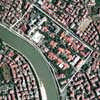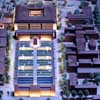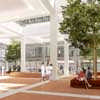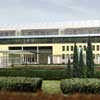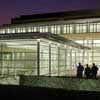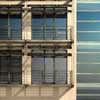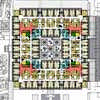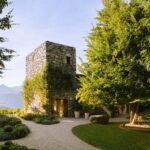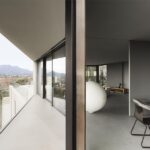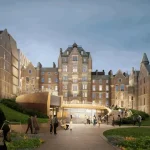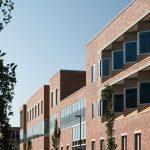Verona Borgo Trento Maggiore Hospital, Building, Project, Images, Design
City of Verona Borgo Trento Maggiore Hospital, Italy
Veneto Hospital Development design by Studio Altieri in Italy
24 Feb 2009
Verona Borgo Trento Maggiore Hospital
New Surgery Centre
City of Verona Borgo Trento Maggiore Hospital, Veneto, Italy
Design: Studio Altieri
1.The hospital in the territory
The original nucleus of the Borgo Trento Hospital Complex, in Verona, was the Alessandri Children’s Hospital, which was inaugurated in 1914 and comprised a single line of buildings looking onto the current Via Mameli.
In 1942 the buildings comprising the expanded hospital system were inaugurated, being situated in the area to the south-west of the Alessandri hospital.
The general layout of the expansion was characterised by the administrative pavilion positioned in Viale Stefani and by two adjacent avenues defining the central area.
The new surgery pavilions faced onto this area, as did the back of the Alessandri pavilion, so that the latter then became the main frontage.
The central area contained smaller buildings.
In recent years the existing buildings have been extended and other blocks have been built in attempts to respond, above all, to the enormous and continuously growing needs of diagnostic and treatment services.
Lastly, the location of the new staff car park, also made necessary by pressing demands for parking space, has further decreased the green areas and increased the fragmentary nature and disaggregation of the entire system.
The hospital area does indeed suffer from disruption by the simultaneous presence and overlapping of different flows from the outside, and to and from the various buildings in the complex. This is because the pavilions are linked by underground passages that cater only for “soiled” traffic and technical services connections, so that the only possible means of transporting emergencies and patients in general is by ambulance.
This flow of patients utilises the internal ground level road system which, at the same time, also carries the traffic of visitors and outpatients using the various structures.
It is therefore clear that this type of hospital with its pavilions and the construction characteristics of the older buildings create problems and heavy costs in terms of management and organisation.
Although the system of green areas in the Maggiore City Hospital has been modified by the transformations and enlargements of the original hospital buildings, the areas have managed to keep their unifying nature, preserving the recognisable identity of the site itself.
The distinctiveness of the whole site is the result of the close relationship between the hospital system, characterised by buildings differing in formal-distributional type, and the system of green areas based on a unified vision of the park.
The presence of substantial numbers of evergreen trees of considerable size in the whole area, such as Cedrus deodara, Cedrus atlantica and Pinus pinaster, constitute the framework of the site landscape and the predominant characterising trait.
2.The concept
The project to reorganise the hospital area must unite the objective functional and medical needs with the need to consider this area as part of the city, for which there are precise compositional regulations.
It is, therefore, not enough to solve the problems of a particular type or types of hospital building by realising constructions that satisfy medical requirements; there is also the desire to create a high quality urban area in which, like the existing buildings, the new constructions are fundamental components.
Essential prerequisites for achieving this desire are the collation, development and protection of the overall type of hospital settlement with its pavilions. That is not so say that each individual building should be saved, but the urban settlement as a whole with its particular characteristics should be preserved, even though recent interventions have distorted its original nature.
Earlier remarks referred to the strong sense of involvement in daily life that characterises the Borgo Trento area, and likewise to the absolutely exceptional morphology, building styles and environmental features of the site.
The site’s position within the urban network of Verona, its privileged relationship with the River Adige, the existing, still-recognisable building layout and the system of green areas, together with resolution of all the functional problems, must all become the core and pivotal values of the project.
It should also be noted that the functional requirements, as indicated in the notice of competition, express a need for significant volumes of new buildings that, if built using the methods used for recent extensions, would imply covering the entire remaining hospital area with buildings or, alternatively, using constructions that would be so high as to be out of scale with the original system and would hence completely undermine the original concept of the layout.
Other kinds of intervention, such as choosing to work in other areas, without taking account of the pavilion system, would lead to evident impoverishment of the overall complex: if no attempt is made to recover a system that as a whole is functioning and has its own identity, this kind of intervention would yet again continue the practice of resorting to sporadic, ad hoc solutions.
It is to prevent the danger of this occurring that the project must be approached as a solution for the entire hospital area, providing indications for the final layout of the whole system.
Only an overall vision will allow this approach to overcome the habit of tackling problems on a short- or medium-term basis. This method no longer proves to be viable because the result of a short-term intervention of limited vision would exact too high a price for the existing pavilion building system to bear.
We therefore wish to stress that the cornerstone of the project should be protection of the existing pavilion system, by reinforcing its axial layout and by inserting the buildings in green surroundings that further enhance the quality of the outdoor space that is typical of this kind of settlement.
A later intervention will aim to improve the functional-formal aspects of the historic entrance building and the square in front, making it the main, representative entrance for the complex.
A final constraint on the project should be fundamental care in recovering the system of green areas; this should be given equal importance to that of the building system, also because this was how it was originally conceived.
3. The Hospital
The architecture for the new Borgo Trento hospital is not a reconstruction, but an invention and a fundamental action: it is the creation of a new community site. The monuments and the historic city are often perceived as containers of events in which everything must be preserved, without further discussion, as evidence of the times, but these parts can be living, continuously evolving pieces for the city of the future.
This project aims, therefore, at expansion and completion, inventing a space in the light of the interrogatives posed by the area and forming a relationship with the existing city.
The proposal is not for a single, plain building, but for a series of typifying elements (the central building, the park, the portico, the piazza), recomposed around an idea relating to the historical fabric and monuments of the city and attempting to configure, in its fragmentary nature, a form of the city on this site.
The new hospital is, therefore, a project of the city and for the city: it is an attempt to transform a great hospital structure, which at the same time is a part of Verona, through human and architectural dialogue.
The concept is of an “open hospital”: this does not just mean a transparent, readable structure, but also a hospital-city, that is to say a complex, multi-functional system comprising areas with different degrees of protection and accessibility and all, in any case, of great environmental value.
Symbolising this concept is the new park, which is not just a hospital garden but a place open to the city that will defuse the fear aroused by illness and isolation.
The architecture should aid and qualify states of mind: perception of the hospital as a place providing a warm reception, hope and care, and for fighting pain and suffering.
Privacy, comfort, a friendly reception, direction-finding, ergonomics are just some of the fundamental concepts of this project and the cornerstones of a design philosophy, the goal of which is Humanisation.
The hospital in this project will not seem an incomprehensible machine.
Its park and its nearness to the heart of Verona make it, first and foremost, a part of the city.
It is transparent because it allows one to see its component parts: the various historic and modern buildings in a continuing dialogue with the park and the diagnostic areas illuminated by the lowered courtyards that “carve through” them.
It is friendly and on a human scale, because the first impression is that of a grand hotel, with its large entrance and lobby, letting in plenty of light and characterised by elements, such as the arcade and shops, that are not usually associated with a hospital and soften the specialist atmosphere to create a more familiar environment.
It is a place of hope and devotion to life, symbolised by the large glass windows in the wards, which help the patient maintain a link with the outside world and the passing day with its changing light and natural colours.
The project is state-of-the-art as regards the provision for space and technology, and most of all as regards flexible design so as to keep up with the fast pace of continually changing systems of treatment and care.
To conclude, the proposed concept for the new Borgo Trento hospital is that of a place centred on the patient and on the city of which he/she is part, built to be as efficient as possible but caring for the person, whether a patient or, equally, a member of staff, for whom the quality of working conditions is of fundamental importance.
4.1 Building typology
The project plans for the realisation of a building intended for those functions having an initial impact on the public, such as information and outpatient clinics, with volumes similar to the original buildings and located on the site of the current supplies dept. pavilion. It will be placed so as to define and terminate a typical courtyard system defined by the entrance pavilion and by the medicine pavilion on one side, with cardiac surgery on the other.
Behind this building, and directly linked with it, is a second, larger building set around a large central courtyard.
The open space, taking its definition from the initial courtyard system and delimited by the existing tree-lined avenues, will assume the characteristics of an urban park, a public space and an element of reference for the entire hospital complex, hiding the medical functions that will be located beneath it.
In actual fact, the need for significant volumes allocated to diagnostics and treatment and, likewise, to the corresponding technological services, has been satisfied by creating a floor at about five metres below the current ground level and corresponding to the level of the Lungadige Attiraglio road.
Siting these volumes at the current zero level would have completely undermined any attempt to re-establish the pavilion system.
The accident and emergency entrance is situated along the Lungadige road and becomes the starting point for the whole functional system destined for diagnostics and treatment services, located in a large dedicated block on a single floor.
Siting the more specialised areas on the new floor, below the actual level of reference for the hospital area, and putting the accident and emergency entrance along the Lungadige Attiraglio road makes it possible to completely free the system of emergency traffic.
This layout is completed by creating two underground pathway systems on two completely separate levels, one for taking patients and clean materials between the new surgery complex and the various existing pavilions, and the other for technical services links and for taking soiled material to the existing underground passages and, via these, to and from all the existing buildings.
The project presents a further proposal to solve the parking problems in the area once and for all, by creating a new staff car park on the Via Mameli side.
The project approach as described above can be implemented in independent, operational phases and in our opinion provides a solution for the functional requirements and core project values as analysed in the previous sections.
The hospital area will take on a new overall quality: not only the realisation of new buildings, but also the creation of important open spaces, the importance of the tree-lined avenues and the clearly defined flows and pathways will contribute to the formation of an “urban” system that is able to hold its own with the rest of the city.
The large central park will become the nucleus of the entire system: a moderating element between the architectures looking onto it, and a socialising, relaxing element for the people who pass through it.
Finally freed of emergency traffic, Piazzale Stefani will return to its role as the interface between Borgo Trento and the hospital area.
Verona Borgo Trento Maggiore Hospital – Further Information
Verona Borgo Trento Maggiore Hospital New Surgery Centre images / information from Studio Altieri 240209
Verona Borgo Trento Maggiore Hospital – Building Information
Appointed designers:
Studio Altieri S.p.A. (capogruppo mandataria)
Studio Von Gerkan, marg und partner
Land S.r.l.
Tifs Ingegneria fellin-siper
S.t.e.p. Studio tecnico professionisti associati
Professional role of Studio Altieri:
Project Coordination, Concept Design, Detailed project design building and structural works, Construction project building and structural works, Direction works
Surface area: 96,296sqm
Beds: 513
Value: € 203.295.913 € 19.334.820 for preparative works
Project progress: Design (Mar 2001 – Jun 2002) Construction (Oct 2004-)
Client: AZIENDA OSPEDALIERA “ISTITUTI OSPITALIERI DI VERONA”
Location: Verona, Italy, southern Europe
Italian Architecture Designs
Contemporary Italian Architectural Selection
Italian Architectural Designs – chronological list
Another Italian hospital by Studio Altieri:
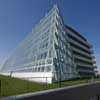
image from architect
New Mestre Hospital : World Architecture Festival Awards 2008
Health Category Finalist
The new Ferrari Centro Stile, Maranello, Northern Italy
Architects: Design International and Planning
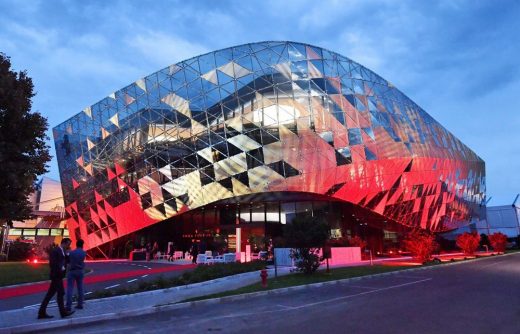
image Courtesy architecture office
Ferrari Centro Stile
Buildings / photos for the City of Verona Borgo Trento Maggiore Hospital New Surgery Centre Italy Architecture page welcome

